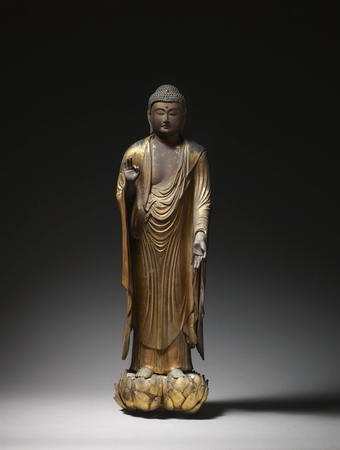Product Description
7678 A gilt-wood figure of Amida Buddha in a delicately flowing robe standing on a double lotus base
The right arm is raised and the left arm is extended with the forefinger and thumb of each hand forming a circle, representing the raigōin mudra, welcoming the believer into Amida’s Great Western Paradise.
The head has gyokugan (inlaid crystal eyes) and is also adorned with crystals representing the byakugō (white spiralling hair) on the forehead and the nikkei-shu (red jewel on the protrusion on top of the Buddha’s head).
Japan 13th century Kamakura period
Dimensions:
Figure: H. 80cm x W. 27cm x D. 20cm (31¾” x 10¾” x 8”)
Stand: H. 11cm x W. 25.5cm x D. 23cm (4½” x 10¼” x 9¼”)
Figure and stand: H. 90.5cm x W. 27cm x D. 24cm (35¾” x 10¾” x 9½”)
Belief in Amida as Lord of the Western Paradise rose in popularity during the late 10thcentury. Based primarily on the concept of salvation through faith, it was not only a religion which appealed to a broad range of people, but also a direct assertion of piety against the dogmatic and esoteric ritual of the more traditional Tendai and Shingon sects. In Amida’s Western Paradise the faithful are reborn, to progress through various stages of increasing awareness until finally achieving complete enlightenment.
Images of Amida, Lord of the Western Paradise, are known in Japan from as early as the 7th century. Until the 11th century the deity was most frequently portrayed in a gesture of teaching and was worshiped primarily in memorial rituals for the deceased. However in the last two centuries of the Heian period worshippers started to concentrate more on the ‘Teachings Essential for Rebirth’ written by the Tendai monk Genshin (942-1017). The teachings describe the horrors of Buddhist hell and the glories of the Western Paradise that can be attained through nembutsu, meditation on Amida or the recitation of the deity’s name.
Despite the apparent absence of formal variations in the images themselves, during the latter part of the Heian period important changes did occur in the nature of the rituals held in front of the Lord of the Western Paradise. By the twelfth century Image Halls dedicated to Amida were the ritual centres of most complexes. The function of memorial services was expanded so they benefited not only the dead, but the living too. Even rituals with no historical connection to the deity, such as the important services at the start of the New Year, were also held there. Of particular significance were the novel ritual practices that were held to guarantee one’s rebirth in Amida’s Western Paradise. Some, such as the re-enactment of the descent of Amida or the passing of one’s last moments before death clutching a cord attached to the hands of the deity, were entirely new whilst others, which included the use of halls dedicated to Amida as temporary places of interment, reflected the fusion of more ancient practices with doctrines of rebirth.
This particular style of Amida Nyorai sculpture is called Annamiyō (Annami-style), a name which is derived from An-amidabutsu, a Buddhist title given to Kaikei (act. c. 1183-1223). Often compared with another Kei-School great master Unkei (d. 1224), Kaikei was one of the most important Buddhist sculptors in Japanese art history, active in the late-Heian to Kamakura periods. Kaikei’s works are generally known to be graceful, while keeping the reality of the figure. With the rise of the Jōdo (Pure Land) Buddhism sect, Kaikei, as a devout believer, produced a number of San-jaku Amida (standing Amida figures of approx. 80cm to 1m high) with raigōin, a mudra welcoming believers into the Great Western Paradise, throughout his career. Their beautifully proportioned faces are gentle and intellectual, bodies are moderately fleshy and the pictorial robes drape delicately. In his later works, the drapery becomes more complicated, making the figures even more graceful. Widely favoured as the ideal embodiment of Amida Nyorai in Japan, Kaikei’s style was carried on and developed by his followers and later generations. Most standing Amida figures produced during and after the time of Kaikei are said to be more or less influenced by his style.
For comparable examples by Kaikei, see:
Nara National Museum ed., The Buddhist Master Sculptor Kaikei: Timeless Beauty from the Kamakura Period, (Nara, 2017), no. 83 (13th century, Daienji temple, Osaka); no. 85 (13th century, Enjōji Temple, Shiga); no. 87 (1221, Kōrinji temple, Nara, Important Cultural Property); p. 156 (1211, Tōjuin temple, Okayama, Important Cultural Property); p.157 (c. 1221, Kōdaiin temple, Wakayama, Important Cultural Property);
Asia Society Museum ed., Kamakura, Realism and Spirituality in the Sculpture of Japan, (New Heaven and London, 2016), p.56-57, no. 4 (c. 1210, Kimbell Art Museum, Texas, no. AP 1984.01 a,b,c)
For comparable examples of Amida Nyorai standing on a double lotus base see:
Tokyo National Museum ed., Tokubetsuten Kamakura-jidai no Chōkoku [Special Exhibition: Japanese Sculpture of the Kamakura Period], exhibition catalogue, (Tokyo, 1975), no. 61 (dated 1259, by Eisen, Tokyo National Museum, Important Cultural Property);
Nara National Museum ed., The Buddhist Master Sculptor Kaikei: Timeless Beauty from the Kamakura Period, (Nara, 2017), no. 62 (attributed to Gyokai, 1212, Jodo-school, Kyoto, Important Cultural Property);
Asia Society Museum ed., Kamakura, Realism and Spirituality in the Sculpture of Japan, (New Heaven and London, 2016), p.102, no. 25 (mid-late 13th century, Asia Society, New York: Mr and Mrs John D. Rockefeller 3rd Collection)
For comparable examples in bronze from Kamakura period see:
Nara National Museum, Bronze Sculpture of the Heian & Kamakura Periods (Special Exhibition), (Kyoto, 1976), p. 23, no. 47 (Yakushi Nyorai,
Ryūsenji temple, Akita), no. 48 (Yakushi Nyorai, dated 1248, Ryūzen, Obama-city, Fukui), p. 32, no. 74 (Amida Nyorai, dated 1314, Kinonesawa, Chiba).
Radio Carbon Dating Ref: RCD-9283









